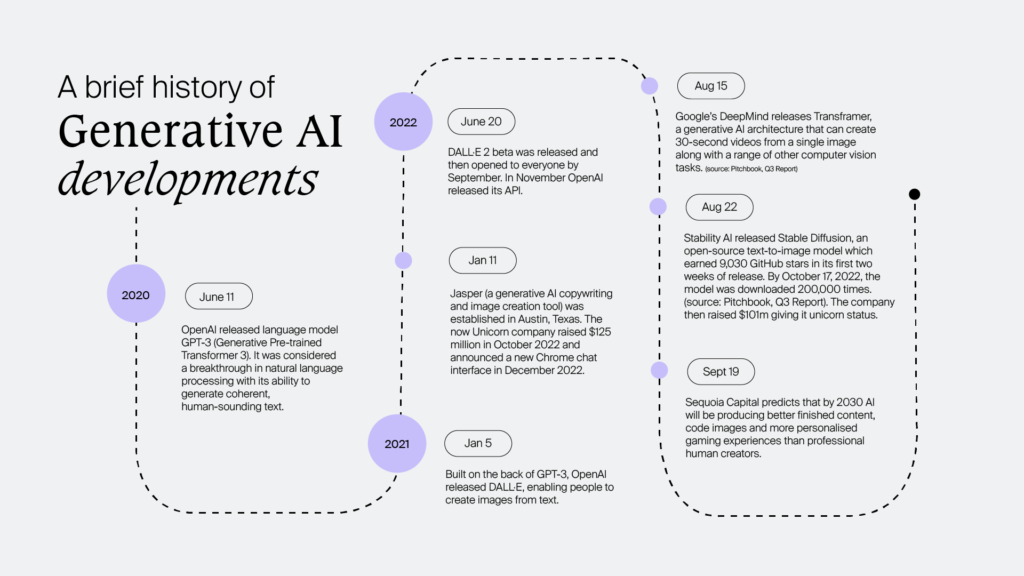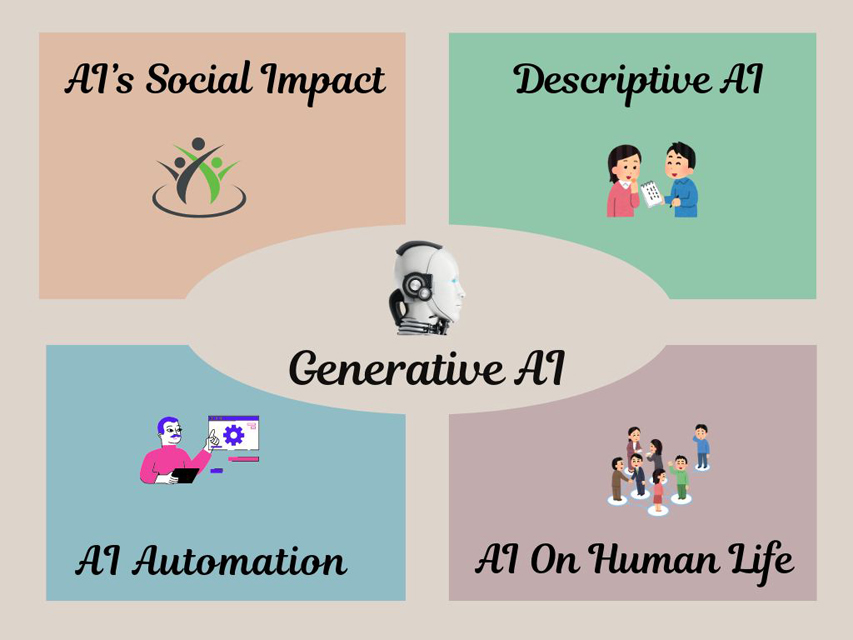What Is Generative AI
Imagine machines that can create brand new images, music, or even text! This is the power of generative AI. Unlike regular AI focused on specific tasks, generative AI learns from existing data to produce entirely new and original content. It’s like having a super-powered copycat that can mimic styles and patterns from photos, songs, or even articles. This technology unlocks exciting possibilities. We can generate new images for creative projects, translate text descriptions into pictures, or even compose music in different genres. However, with great power comes great responsibility. There’s a risk of people using generative AI for bad purposes, like creating fake videos or spreading misinformation. As generative AI evolves, researchers are working on making it more reliable, unbiased, and easier to understand. This will ensure we can harness the full potential of this technology for good.
Additionally, Generative AI Solutions encompass cutting-edge technologies that leverage pattern recognition to generate novel content across various domains. By integrating large language models, these solutions can produce high-quality text, music, and images that exhibit sophisticated patterns and styles. In the realm of Business Analytics, Generative AI Solutions offer transformative capabilities, enabling organizations to generate insightful reports, forecasts, and visualizations. Moreover, they can be utilized for data mining purposes, uncovering hidden insights and trends within vast datasets to drive informed decision-making. As the field of generative AI continues to advance, efforts are underway to enhance its capabilities and mitigate potential misuse, ensuring its responsible and ethical deployment in diverse applications.
Brief history of AI’s impact on society
Since its inception, the impact of AI on society has been profound and multifaceted. From its early applications in expert systems and robotics, AI has steadily advanced to permeate various aspects of modern life. In the 21st century, AI-powered technologies have revolutionized industries such as healthcare, finance, transportation, and entertainment. However, the widespread adoption of AI has also raised concerns. These include job displacement due to automation, algorithmic bias in decision-making systems, potential privacy violations from data collection, and the ethical implications of machines making autonomous choices. As AI continues to evolve, society grapples with the challenges of harnessing its potential for good while mitigating its risks. This emphasizes the importance of responsible development, regulation, and ensuring equitable access to AI technologies for everyone.

(Source :- Generative AI’s impact on investing | VentureCrowd )
Generative AI and Descriptive AI
Generative AI focuses on creating new data or content that is similar to existing examples, often through the synthesis of patterns learned from a dataset. This includes techniques such as generative adversarial networks, variationally autoencoders, and autoregressive models, which are capable of generating images, text, audio, and other types of content. Generative AI is particularly noteworthy for its ability to produce novel and diverse outputs, enabling applications such as image generation, text-to-image synthesis, and creative content creation.
On the other hand, descriptive AI is concerned with analysing and understanding existing data to extract insights, patterns, and relationships. This encompasses a wide range of techniques such as machine learning algorithms, natural language processing, computer vision, and data mining, which are used to classify, predict, cluster, or summarize data. Descriptive AI plays a crucial role in tasks such as data analysis, recommendation systems, sentiment analysis, and predictive modelling, where the goal is to extract meaningful information from datasets to inform decision-making processes.
Automation Through AI in Past
Automation through AI has historically been evident in industries such as manufacturing, where robots and automated systems have been used for tasks such as assembly line production, quality control, and material handling.
In customer service, AI-powered chatbots and virtual assistants have automated interactions with customers, handling routine inquiries, providing support, and facilitating transactions.
AI has been applied in finance for algorithmic trading, where automated systems analyse market data, identify trading opportunities, and execute trades at high speeds, often without human intervention.
In healthcare, AI-driven diagnostic systems and medical imaging technologies automate the interpretation of medical images, assisting healthcare professionals in diagnosing diseases and planning treatments.
AI has also played a role in transportation through autonomous vehicles, where advanced AI algorithms enable self-driving cars to navigate roads, interpret traffic conditions, and make driving decisions without human input.
Within administrative tasks, AI-driven software applications automate document processing, data entry, scheduling, and other routine office tasks, increasing efficiency and reducing the need for manual labour.
How AI Will Impact Human Life in Next 5 Years
AI will analyse your data to create custom experiences in entertainment, shopping, and healthcare, recommending things you’ll love. Leveraging pattern recognition, AI will tailor recommendations even more precisely to your preferences.
AI will speed up medical research, improve diagnoses, and even create personalized treatments by analysing pictures, predicting risks, and finding new drugs. With the assistance of large language models, AI will enhance its ability to comprehend vast amounts of medical literature and assist in research endeavours.
AI will automate repetitive tasks in factories, customer service, finance, and offices, freeing people up for more interesting work. Through advanced pattern recognition capabilities, AI will streamline workflows and boost efficiency across various industries.
Cars, drones, and robots will get smarter using AI to navigate, make decisions, and work together, leading to safer and faster deliveries and travel. Enhanced by pattern recognition algorithms, AI-powered systems will navigate complex environments with greater precision and adaptability.
As AI becomes more integrated into our lives, we’ll need to ensure it’s used fairly and protects our privacy. This might entail establishing new laws for AI that safeguard against biases and uphold privacy rights.


